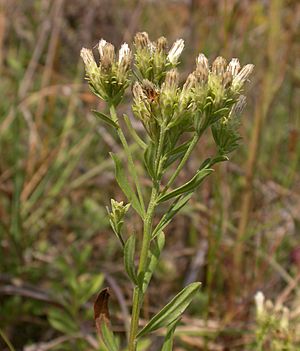Columbian whitetop aster facts for kids
Quick facts for kids Columbian whitetop aster |
|
|---|---|
 |
|
| Conservation status | |
| Scientific classification | |
| Kingdom: | |
| (unranked): | |
| (unranked): | |
| (unranked): | |
| Order: | |
| Family: | |
| Tribe: |
Astereae
|
| Genus: |
Sericocarpus
|
| Species: |
S. rigidus
|
| Binomial name | |
| Sericocarpus rigidus |
|
| Synonyms | |
|
Aster curtus |
|
The Columbian whitetop aster (scientific name: Sericocarpus rigidus) is a beautiful flowering plant. It belongs to the aster family, which is a very large group of plants. This plant is special because it's native to the Pacific Northwest region of North America.
You can find it growing in places like southern Vancouver Island in British Columbia, and south along the coast into Washington and Oregon.
Contents
Discovering the Columbian Whitetop Aster
The Columbian whitetop aster is a perennial herb. This means it lives for more than two years and grows back each season. It has special underground stems called rhizomes that help it spread.
What Does This Plant Look Like?
This plant can grow to be about 37 centimeters (about 15 inches) tall. Its leaves are somewhat oval-shaped and can be up to 6 centimeters (about 2.4 inches) long.
The plant produces clusters of flower heads. Each flower head is about one centimeter long. They usually have white or off-white disc florets in the center. You might also see a few white ray florets, which look like petals, around the edges.
Where Does the Columbian Whitetop Aster Live?
This aster loves to grow in grassland areas. These grasslands are often filled with a type of grass called Idaho fescue.
The soil where it grows can be different depending on the location. In the northern parts of its range, it prefers gravelly soils. These soils were formed by glacier activity long ago. Farther south, it grows in clay soils. The soil is usually moist for most of the year but gets dry in the summer.
Friends and Neighbors of the Aster
Many other plants share the same habitat with the Columbian whitetop aster. Some of its plant neighbors include:
- Snowberry (Symphoricarpos albus)
- Serviceberry (Almelanchier alnifolia)
- Oregon sunshine (Eriophyllum lanatum)
- Early blue violet (Viola adunca)
Unfortunately, some introduced species have also moved into these habitats. These are plants that are not native to the area. Examples include Scot's broom (Cytisus scoparius) and yellow hairgrass (Aira praecox).
What Challenges Does It Face?
The Columbian whitetop aster faces several challenges that threaten its survival.
Threats from New Plants
One big problem is the invasion of its habitat by introduced species. These non-native plants can outcompete the aster for space, sunlight, and nutrients.
Habitat Loss and Other Dangers
Other threats include losing its natural home to new buildings and roads. Activities like off-road vehicles and military training can also disturb its habitat. Even efforts to prevent wildfires can sometimes change the environment in ways that harm this plant.


